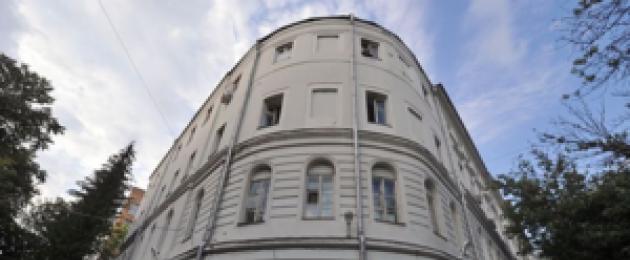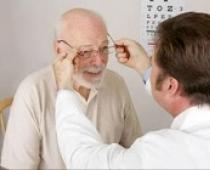All the activities of the ophthalmology department of the hospital 67 are aimed at the implementation of the priority area - eye microsurgery, which includes the treatment of diseases of the retina of severe somatic patients, as well as work with cataracts and glaucoma. It is worth noting that the department specialists also provide assistance to those somatic patients who, in addition to eye diseases, have been diagnosed with such complex diagnoses of a chronic nature as a history of stroke, heart attack, diabetes mellitus and aggravated hypertension.
Patients who have entered the eye of hospital 67, can count on all kinds of ophthalmologic consultations that are needed to clarify the situation regarding visual impairment and eye diseases. Direct consultations themselves are conducted only by highly qualified ophthalmologists. If necessary, scientific specialists are invited to the department. We are talking about doctors and candidates of medical sciences. If there are questions that require a different profile, consultations are held with the participation of related specialists (endocrinologist, otorhinolaryngologist, therapist).
The ophthalmologic department of GKB 67 can also offer any type of ophthalmologic examination: coherent computed tomography, ultrasound diagnostics, subjective and objective examination of refraction and visual acuity, etc.
The eye section 67 of the hospital has equipment that allows laser and microsurgical operations to be performed. Specialists also have access to the latest computer and opto-electronic diagnostics, with which it is possible to provide various diagnostic and physiotherapeutic activities. Among other equipment, there are various means of modern eye surgery.
Due to the fact that the clinic has a high level of technical equipment, the most complex diagnostic and therapeutic procedures are performed at a high level of safety and efficacy.
The specialists of the Department of Eye Microsurgery 67 of the hospital actively use methods of seamless, low-impact, bloodless surgery and physiotherapy.
All personnel who work in the ophthalmology department have high qualifications and skills gained as a result of passing special training. The professional level of each of the doctors is confirmed by a specialized certificate.
The Ophthalmology Department of the 67th Hospital of Moscow combines the work of 7 specialists with a corresponding diploma. One of them is a doctor of the 1st category, four received the highest category and two specialists defended their PhD in medicine.
The Moscow Ophthalmological Clinical Hospital, located at 7 Mamonovsky Lane, is a special state institution, which is supervised by the Department of Health. In this institution, people with various eye pathologies can get help, carry out emergency operations.
About clinic
Ophthalmologic Clinical Hospital is considered one of the oldest eye clinics in the whole world. According to historical data, this institution has been operating for 180 years.
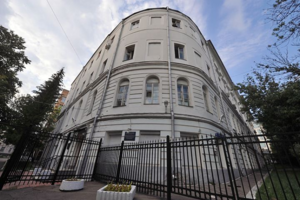 Opening of the ophthalmologic clinic at the end of January 1826. The idea of creating this kind of hospital belonged to Dmitry Golitsyn, who at that time held the post of Governor-General of Moscow. Initially, the clinic was created in order to provide people in need with the opportunity to receive quality medical care.
Opening of the ophthalmologic clinic at the end of January 1826. The idea of creating this kind of hospital belonged to Dmitry Golitsyn, who at that time held the post of Governor-General of Moscow. Initially, the clinic was created in order to provide people in need with the opportunity to receive quality medical care.
Despite such a long period of time, the clinic is still very popular.
This is largely due to the presence in the medical center of the following things:
- during one shift, the clinic doctors are able to receive about 500 people;
- the hospital has the ability to place 240 patients.
About 10–11 thousand ophthalmologic operations are performed in the hospital each year, this number also includes high-tech operations.
Doctors of the clinical hospital treat the following types of eye diseases:
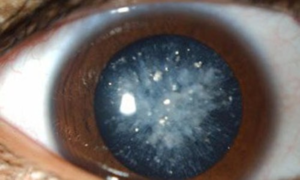
And this is not a complete list of ailments that doctors of the clinic can handle.
Doctors Clinical Hospital
At this stage of time in the ophthalmologic clinical hospital works, without taking into account professors and teachers of the department, 2 doctors of medical sciences, 14 candidates for doctor of medical sciences, 72 doctors with the highest qualification.
The following doctors are particularly noteworthy:
- Arefieva E. I - occupies the position of oncologist in the hospital at Mamonovsky Lane 7;
- Burdenko I.G - highly qualified ophthalmologist;
- Ilyukhin O.E - surgeon of the clinic;
The rest of the list of doctors of the clinic is presented in a separate section. on the official site hospitals.
Hospital departments
On the territory of the clinic, located in Mamonovsky lane 7, there are six specialized departments:
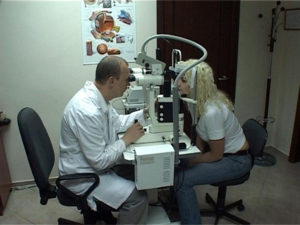
In order for patients to get more detailed information about the services that are present in each department of the ophthalmological hospital and the site was created.
Mode of operation and recording
Ophthalmological hospital, located at Mamonovsky lane, house 7, open from Monday to Saturday, Sunday - day off.
Opening hours of the clinic and registry are the same.
From Monday to Friday, the medical facility receives patients from 8:00 to 20:00, on Saturday - from 8:00 to 16:00.
Emergency room works round the clock and seven days a week.
 The office where eye prosthetics is performed only works on Wednesdays and Fridays, in the period from 14:30 to 20:00.
The office where eye prosthetics is performed only works on Wednesdays and Fridays, in the period from 14:30 to 20:00.
In order to get an appointment with a doctor, it is necessary to do it personally or with the help of relatives. registry entry hospitals.
To make an entry in the registry, you must have the following documents with you:
- referral to a reception from a clinic located in the area;
- medical policy;
- a document that confirms the person (passport or birth certificate, it is permissible to show the rights).
It is impossible to make an appointment in electronic mode, since the hospital belongs to the third level medical institutions. Such establishments make patients only with direction from the doctor, where the alleged diagnosis of the patient is indicated. All phones that can be contacted in case of loss of a coupon or for other issues are presented on the hospital website.
How to get to the clinical hospital?
Due to the fact that the ophthalmologic hospital is located at 7 Mamonovsky lane, it is quite easy to get to it.
The following routes exist:
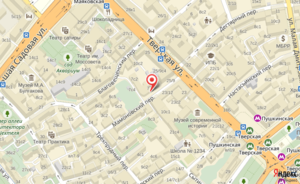
A scheme of the path is attached to the hospital website.
Ophthalmologic Clinical Hospital is the oldest ophthalmic clinic in the world. Its history goes back almost 180 years. On January 26, 1826, the Governor-General of Moscow, Prince Dmitry Vladimirovich Golitsyn, supported the wishes of public figures about the need to create a specialized eye hospital in Moscow. The hospital was conceived to provide outpatient and inpatient eye care primarily to needy, poor people and was created on the donations of the townspeople.Prince Golitsyn organized and headed the donation committee. The goals that the committee has set for itself are expressed in the following words: “It has been proposed to accept a patient of all ages, gender, and rank, mostly the poor, without any payment for maintenance and use, to the generally useful institution.”
The Eye Hospital was opened on July 11, 1826 in the Lange house at the Nikitsky Gate and had 20 beds and a room for receiving patients. The capacity of the ambulatory was 30 patients per day.
The first chief physician was Peter Fedorovich Brosse. He worked in this position for 31 years, leaving all his salary to the hospital.
With donations from citizens on May 8, 1830, Countess Dmitriyeva-Mamonova bought a stone house with furniture and outbuildings on the corner of Tverskaya Street and Mamonovsky Lane, and on November 15, 1830, the eye hospital housed in this building, where it is still located.
In 1845, in the building of the eye hospital a house church of Christ the Savior was built, which was consecrated by the Metropolitan of Moscow Filaret.
During World War I, an infirmary for wounded soldiers was opened in the building of the eye hospital.
Before the Great Patriotic War, in connection with the reconstruction of Tverskaya Street, the building of the Eye Hospital was moved to its present place - in Mamonovsky Lane.
During the Great Patriotic War, an eye evacuation hospital was deployed in the hospital, where more than 9,000 wounded were treated, of which 82.4% returned to service, 10398 operations were performed.
From the first years of existence in the Moscow Eye Hospital, hard work was carried out to provide specialized ophthalmological care to the population of Moscow.
Over the years, the hospital was headed by PF. Brosse (1826-1857), V.F. Brosse (1857-1864), prof. G.I. Brown (1864-1897), Ph.D. S.N. Lancechnikov (1897-1911), prof. Ss Golovin (1911-1917), N.N. Disler (1917-1930), A.E. Nadzharov (1930-1938), B.M. Lapuk (1938-1944), E.B. Rabkin (1944-1946), Aidelman (1946-1947), prof. M.L. Krasnov (1947-1951), I.A. Lyubchenko (1951-1979), Honored Doctor of the Russian Federation - V.V. Perlamutrov (1979-1987), Honored Doctor of the Russian Federation Zhitenev V.M. (1987-2009).
Well-known ophthalmologists, Prof. V.P. Odintsov, A.N. Maklakov, V.P. Fears.
Academicians V.P. Filatov and M.I. Averbach.
Within the walls of the hospital, many ophthalmologists finished clinical residency, which later became famous scientists: R.A. Gundorov, A.F. Brovkina, E.S. Libman, V.I. Morozov, N.K. Serova, Z.I. Frost, etc.
Over the years, highly qualified doctors, Ph.D. EAT. Bochaver, S.E. Schwartz, E.M. Ivanova, A.L. Klykova, S.Ya. Zolotnikova, V.F. Zheleznova, L.S. Gudkov and others.
As ophthalmology developed, specialized hospital and diagnostic services were created by the hospital staff.
The pathological laboratory is headed by Ph.D. V.M. Shepkalova. Laboratory staff V.M. Shepkalova, A.A. Kharasanyan-Tade and O.N. Disler created the atlas "Intraocular Tumors", which became an academic publication.
In the post-war years, a functional diagnostics room (initiated by Prof. NA Vishnevsky), a physiotherapy department (EI Shapiro), a complex refraction and strabismus office (Akkerman), an eye prosthetic room (VN Vaneks) were organized.
At the end of the 50s, the country's first ophthalmic oncology room (GG Zyangirov) with a radioisotope laboratory (N.G. Perezhogin) and the first specialized room for the diagnosis and treatment of eye tuberculosis (N.S. Gontoar), the first
- In contact with 0
- Google+ 0
- OK 0
- Facebook 0

